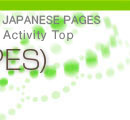
•Year started: 2007
•Actor: Kanagawa Prefecture
Although Kanagawa Prefecture is located in an urban area, all of its drinking water is sourced within the city boundaries, mostly from the Sagamigawa and Sakawagawa Rivers. Beginning with the early development of the Sagami Dam Construction Plan and ending with the completion of the Miyagase Dam in 2001, the prefecture has a long history of water source development projects, which has supplied the water resources supporting economic growth and welfare of its citizens.
However, the water reserved in the dams is the blessing of nature, nurtured in the natural environment of forests and rivers in the water sources areas. Although water recharge and purifications services must be maintained to preserve a healthy environment, the deterioration of forests and delayed sewage treatment in headwater areas have presented serious issues.
To preserve and pass on to future generations the rich water resources secured through past efforts and to guarantee the stable supply of high-quality water in years to come, water conservation and restoration efforts must be launched before it is too late to restore the natural environment of water source areas. These undertakings should be begun now and continued in the long-term.
The two river systems of Sagamigawa and Sakagawa Rivers supply 90 percent of the tap water used in Kanagawa Prefecture. The water is mostly collected in dams built within the prefecture, but 80 percent of the water catchment area is located in Yamanashi Prefecture. Groundwater, which accounts for 7.2 percent of the prefecture's water supply, sources the tap water used in Hatano City and Zama City and other municipalities in the western part of the prefecture.
The water catchment forests were completely cleared during and after World War II and replanted with Japanese cedar and hinoki cypress under a national program to plant commercial forests. As a result, although forests increased significantly in volume, they entailed the risk of being abandoned as forestry became unprofitable. Therefore, many privately-owned planted forests have deteriorated. Furthermore, the natural forests in the Tanzawa mountain range which constitute an important part of the prefecture's water source forests have become degraded as a consequence of decreased underbrush caused by the atmospheric impact of photochemical oxidants and higher concentrations of browsing deer. This has dried the soil and increased soil runoff, which, accompanied by the outbreak of sawflies, have weakened and killed beech and fir, therefore degrading the ecosystem.
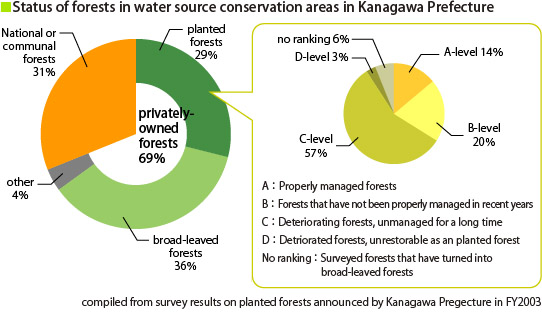
Although both Sagamigawa and Sakawagawa Rivers meet national environmental standards in the main rivers, the Sagamigawa River is contaminated in some parts of its tributaries. Lake Sagami and Lake Tsukui, also in compliance with the standards, are both eutrophied lakes with high nitrogen and phosphorus concentrations promoting increased growth of blue-green algae. The groundwater has higher concentrations of nitrate-nitrogen, nitrogen-sulfur and organochlorine compounds than environmental standards in many parts of the prefecture. Some groundwater sources which previously provided drinking water have ceased to supply water after detection of pollutants. Against this backdrop, the quality of prefectural water sources unfortunately do not satisfy the expectations of all prefectural citizens.
Since 2000, the Kanagawa Prefectural Government discussed and exchanged opinions with its citizens and municipalities on policy measures to conserve and restore its water source environment and on how to fund such measures. This was based on its acknowledgement that in order to steadily and continuously supply quality water, it is necessarily to promote comprehensive long-term efforts to conserve and restore the forests which nurture rich water as well as the pure water sources. Based on these discussions, the prefecture drew up the Kanagawa Basic Policies for Conservation and Restoration of Water Source Environment, which identifies its overall measures for the next 20 years. In 2006, it also formulated the Kanagawa Five Year Action Plan for Conservation and Restoration of Water Source Environment which explains the programs to be carried out in the first five years under the Basic Policies.
In order to sustainably carry out the programs for conserving and restoring the water source environment it became necessary to secure stable financial sources, apart from the unstable general revenue which was easily affected by economic trends. In 2007, Kanagawa Prefecture decided to increase the tax rates of the prefectural inhabitant tax on individuals (annual burden of approximately 950 yen per taxpayer), comprising per capita rates and those based on income levels. The tax rate was determined based on the total expenses newly required to implement the programs stipulated in the Five-Year Action Plan.
Kanagawa's tax program differs from other prefectural forest environment taxes in terms of program coverage. It not only addresses forest conservation but also includes sewage treatment and groundwater conservation. Because it aims to establish a comprehensive policy framework that deals with both securing a stable supply of water and preserving water quality, forest conservation is considered one of many measures to retain the water circulation services of the ecosystem.

•Kanagawa Basic Policies for Conservation
and Restoration of Water Source Environment
The Kanagawa Basic Policies for Conservation and Restoration of Water Source Environment identifies the basic ideas of comprehensive and systematic policies to promote conservation and restoration of the water source environment as well as guidance on the development of measures by policy area for the next 20 years.
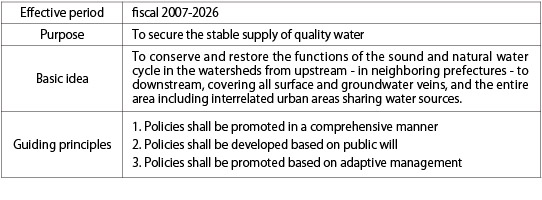
•Kanagawa Five-Year Action Plan for Conservation
and Restoration of Water Source Environment
In order to effectively and steadily promote efforts to conserve and restore the water sources environment according to the Basic Policies, the Five-Year Action Plan defines programs to be implemented in the first five years of the 20 years covered by the Basic Plan.
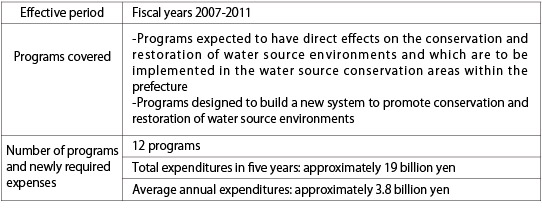
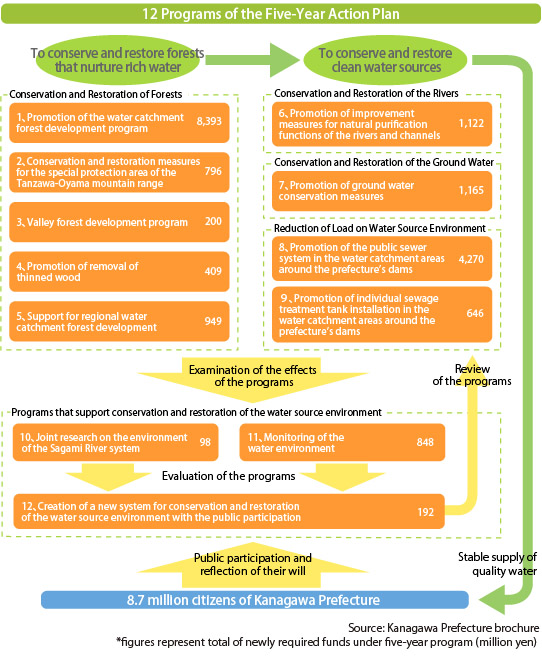
During the first two years of the plan (fiscal years 2007-2008), most of the programs have progressed according to the Plan, with the excepetion of a few projects implemented at the municipality level.
The Kanagawa Citizens'Council for the Conservation and Restoration of Water Source Environment, comprising 30 members, including experts, representative of relevant organizations and publicly recruited committee members, deliberates policy measures in order to incorporate public opinion in each level of policy development, namely, planning, implementation, assessment and review.
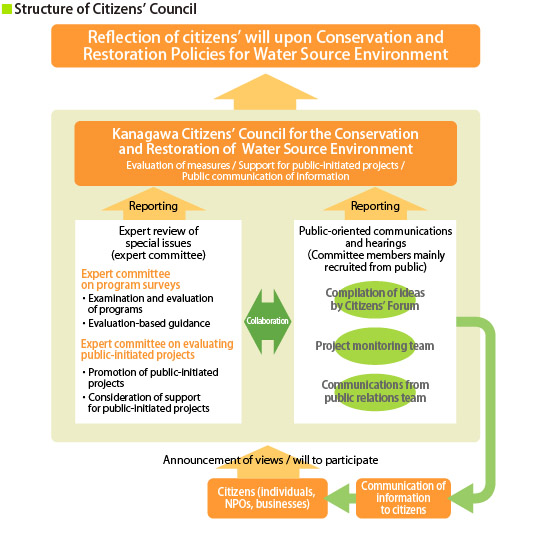
•References
·Kanagawa Citizens’ Council for the Conservation and Restoration of Water Source Environment
(2010) Status and Issues of Efforts for the Conservation and Restoration of Kanagawa’s Water Source
Environment : Report on Review of Special Programs Funded by Water Source Conservation Tax
·Kanagawa Prefecture (2008) In Pursuit of Conservation and Restoration of Kanagawa’s Water
Source Environment
·Kanagawa Prefecture (2010) In Pursuit of Conservation and Restoration of Kanagawa’s Water
Source Environment: Outline of Plan for Conservation and Restoration of Water Source Environment
and Tax Program (available in Japanese only)
·Takai, Tadashi (2007) The Current Status and Issues of Local Environment Taxes: A Study of
Kanagawa Prefecture’s Water Source Tax in Seeking an Ample Tax Source and Local Corporate
Taxation (Report of the Working Group on Kanagawa Prefecture’s Local Tax System), Chapter 4,
p37-54 (only in Japanese)
•Special thanks to
Kanagawa Prefecture (Environmental Agricultural Administration Bureau)

